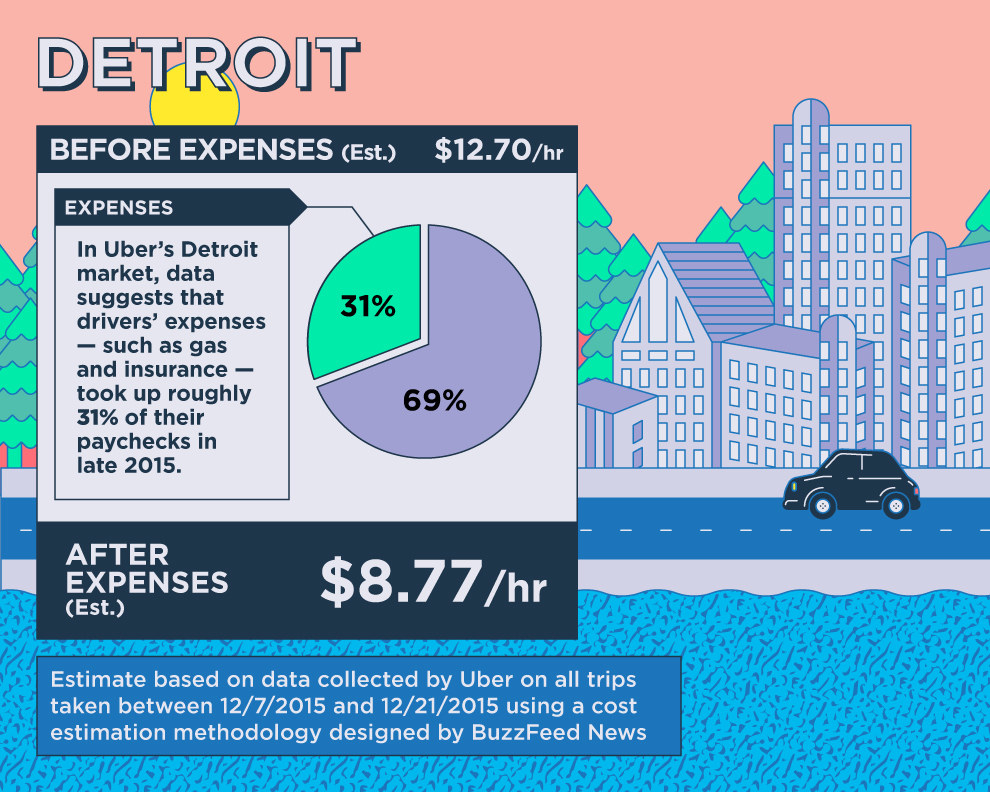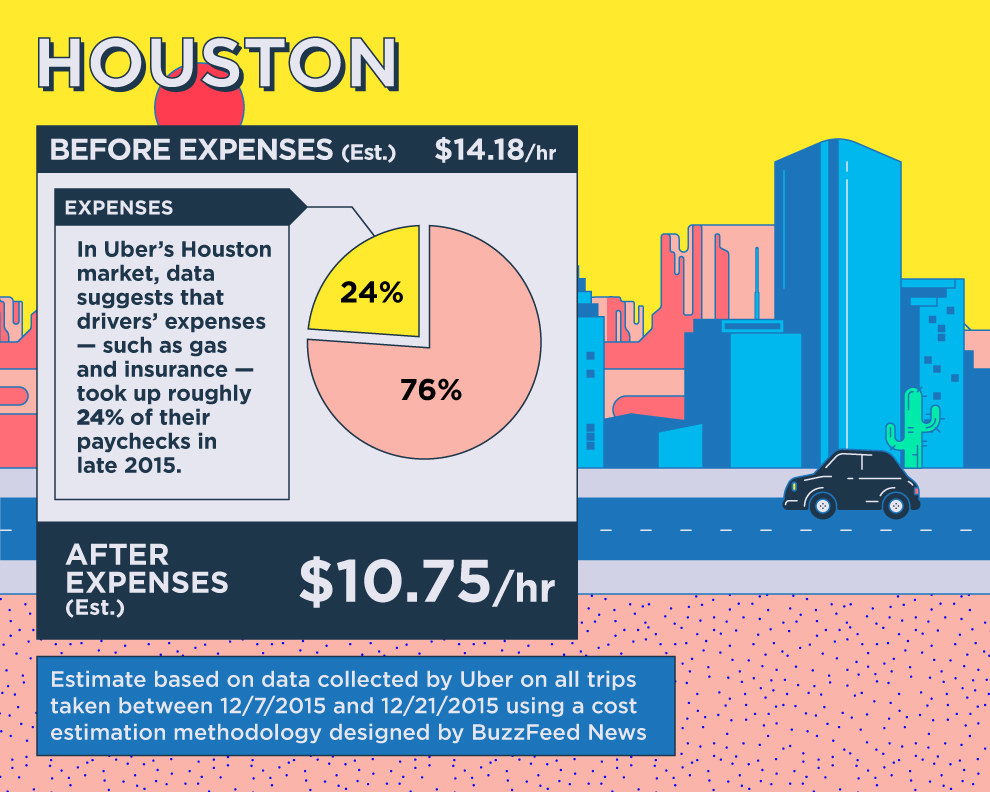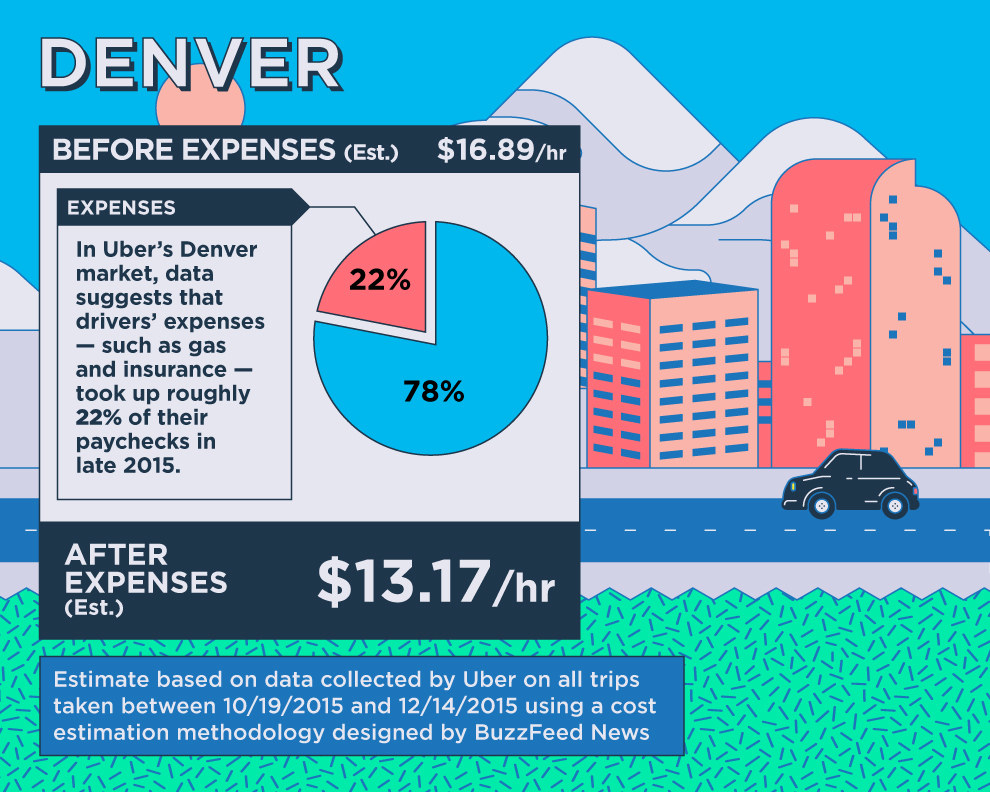Uber says that its drivers are as much its customers as its passengers are, and that its ride-hail platform is a path to personal freedom and financial independence. In 2013, the company told the Wall Street Journal that the “typical” Uber driver takes in more than $100,000 in annual gross fares. (Uber now disputes this characterization.)
More recently, Uber chief adviser and board member David Plouffe has touted the ride-hail platform as a pathway to a modest, more attainable American dream. But according to leaked internal price modeling data, and Uber’s own calculations provided to BuzzFeed News in response to that leak, drivers in some markets don’t take home much more than service workers at major chains like Walmart when it comes to net pay.
Internal Uber calculations, provided to BuzzFeed News by Uber, based on data spanning more than a million rides and covering thousands of drivers in three major U.S. markets — Denver, Detroit, and Houston — suggest that drivers in each of the three markets overall earned less than an average of $13.25 an hour after expenses.
In addition, BuzzFeed News examined a trio of spreadsheets, provided by a source who worked with Uber pricing data, that contain separate but related data on tens of thousands of trips taken in the Denver, Houston, and Detroit markets during two- or eight-week periods in late 2015. Uber employees used these spreadsheets to evaluate potential outcomes of the very price cuts the company would ultimately implement in January 2016.
These documents and the internal Uber communications associated with them offer an unprecedented look at the data on which Uber builds its business, and on which the company’s drivers build their livelihoods.
Uber says it doesn’t know how much drivers on its platform actually earn per hour, after expenses. Still, Uber’s internal pricing models, found in the spreadsheets provided to BuzzFeed News, do generate rough estimates of driver net pay. But in internal communications seen by BuzzFeed News, Uber explicitly discourages employees from comparing these estimates to the minimum wage.
A BuzzFeed News review of the rough internal net pay estimates contained in the leaked documents determined that the models Uber used are highly abstracted and oversimplify certain key calculations. Rather than relying on Uber's figures, BuzzFeed News conducted an independent analysis of the raw trip data and driver data. Uber subsequently recalculated BuzzFeed’s estimates using a broader and more detailed set of internal data — which it declined to share directly with BuzzFeed News. The company did, however, conduct this recalculation according to BuzzFeed News’ methodology — which it said was “solid” — and did so in the presence of a BuzzFeed News editor and reporter.
Based on these calculations, it’s possible to estimate that Uber drivers in late 2015 earned approximately $13.17 per hour after expenses in the Denver market (which includes all of Colorado), $10.75 per hour after expenses in the Houston area, and $8.77 per hour after expenses in the Detroit market, less than any earnings figure previously released by the company.
To be sure, not all drivers net the same hourly income; more experienced drivers may, for example, gross more fares per hour or manage their expenses more carefully. And, because the Uber spreadsheets reviewed by BuzzFeed News didn’t contain hard data on each driver’s expenses, this analysis relies on a few basic assumptions — based in large part on the same assumptions Uber used in its pricing models — which made it possible for BuzzFeed News to roughly estimate drivers’ overall effective hourly wages.
Those assumptions:
- Contractors drive a $16,000 vehicle, which has a 250,000-mile lifetime, resulting in depreciation costs of 6.4 cents per mile.
- Gas costs drivers $1.75 per gallon and the vehicle gets 25 miles per gallon of gas, resulting in gas costs of 7 cents per mile.
- Insurance, maintenance, and miscellaneous costs add up to $3,000 per year, or $1.50 per hour if the contractor drives 40 hours per week, 50 weeks per year.
(Read more about the methodology here.)

Detroit
“I like the job. But financially, it’s not doing it for me.”
This according to Steve Rogers, a 61-year-old driver who told BuzzFeed News that he’s been on the platform about a year. His experience jibes roughly with the data Uber gathered on Detroit, where the typical full-time driver barely earned more than Michigan’s current minimum wage of $8.50 per hour.
Of course, because Uber drivers are not employees of the company, Uber is not legally obligated to pay them the minimum wage.
That’s less than the $10 an hour Walmart promised to pay its employees in 2015.
Uber’s data represents all trips taken in Detroit between Dec. 7 and Dec. 21, 2015. During that period, Detroit drivers earned approximately $13.70 an hour before expenses and — given the assumptions above — about $8.77 an hour after expenses, according to BuzzFeed News estimates that were supplemented by additional data from Uber. That’s less than the $10 an hour Walmart promised to pay its employees in 2015.
Contract and wage work are not perfectly comparable. Uber argues that retail employees at companies like Walmart don’t enjoy the same independence and flexibility as Uber drivers. But as employees, Walmart workers are often entitled to benefits that contract Uber drivers don’t receive.
Rogers, a retired manager at an inventory company, said Uber is his primary source of income. He said he drives about 30 hours per week and makes around $400 before expenses, $90 of which he spends on gas. His plan is to keep driving for about a year, until he qualifies for Social Security. “I’m kind of stuck doing this until I find something else,” he said, “which is hard to do at my age.”

Houston
Drivers in Houston appeared to make a better living than drivers in Detroit, according to Uber’s data. During the period of Dec. 7 to Dec. 21, 2015, Houston drivers earned approximately $14.18 an hour before expenses and about $10.75 an hour after expenses, according to BuzzFeed News estimates supplemented by additional Uber data. That’s significantly less than the $15 wage fast-food workers across the country are fighting for.
John Cerasuolo of Houston calculated that his earnings are "consistently anywhere from $12.50 to $17 an hour, depending on the surge." When Cerasuolo first signed up with Uber in early January 2016, he said learning the ropes was frustrating and financially disappointing. Now that he better understands the system, Cerasuolo said his earnings improved — but the long days can be draining.
“Yesterday morning I got up, headed out at 4:45 a.m., took a break to come home and bring my son to school, then worked until 3 p.m., and I grossed $102,” Cerasuolo told BuzzFeed News during a May interview. “I could have gone back out that night, but I was exhausted.” Cerasuolo first began driving for Uber to earn some additional cash alongside his day job, but he’s been out of regular work since early May. After searching for something more manageable than Uber, Cerasuolo decided to switch career tracks altogether and plans to earn his teaching certificate this summer.

Denver
Of the three markets for which BuzzFeed News received trip data, the Denver market was the most lucrative. Drivers working between Oct. 19 and Dec. 14, 2015, earned approximately $16.89 an hour before expenses and about $13.17 an hour after expenses, according to BuzzFeed News estimates supplemented by additional information from Uber.
Jody, a Denver driver who asked to be identified by first name only for fear that Uber might deactivate his account, said that driving part-time for Uber during the weeks when this data was collected worked out pretty well — until he was laid off from his part-time tech support job in mid-January, right around the same time that Uber cut prices.
“It’s just enough to cover bills,” Jody told BuzzFeed News.
Jody said he typically drives from 6:30 a.m. until early afternoon, when he takes a break during the slow hours to avoid wasting gas, which costs him about $100 a week. If gas prices continue to rise, Jody said that continuing to drive for Uber full-time may not be sustainable. “I'm hoping to get out of it in the next month or two,” he said. “But that depends what kind of luck I have finding a full-time job.”
In early 2015, a study commissioned by Uber found that drivers in 20 cities, including New York, Los Angeles, San Francisco, and Boston, were grossing around $17 an hour. The study, co-authored by Princeton economist Alan Krueger and Uber head of economic research Jonathan Hall, relied on data provided by Uber and produced the most modest estimates of driver earnings prior to this article.
But the $17-an-hour figure was based on data from 2014, when Uber rates in most cities were higher than they were in late 2015. It was also based on gross earnings and did not account for driver expenses. Krueger told BuzzFeed News he decided to base his estimates on gross earnings alone because he “did not have data on mileage or any of the other information required to make a credible estimate of expenses."
Uber says it “retained” Krueger to study “driver flexibility,” and as such, driver costs were not “part of the scope” of his 2015 report. The company told BuzzFeed News that the economist has been working independently on a follow-up paper aimed at estimating driver expenses, for which the company has furnished mileage data.
According to the calculations provided to BuzzFeed News, the cost of gas, vehicle depreciation, and insurance can eat up roughly a quarter of drivers’ gross pay. The data suggests that expenses amount to roughly 22% of full-time drivers’ gross pay in Denver, 24% in Houston, and 31% in Detroit.
Dean Baker of the Center for Economic and Policy Research, who reviewed Krueger’s paper, told BuzzFeed News that "with Uber's data on trip mileage it would have been possible to come up with reasonable estimates of the net pay of drivers, after deducting expenses.”
Internal Uber communications show employees were instructed that because of “variable driver activities” the company couldn’t calculate “the costs actually incurred by drivers.” And, indeed, every driver is different; expenses vary based on the cost of insurance, maintenance, and gas, as well as the vehicle’s efficiency and rate of depreciation, among other factors. But the spreadsheets obtained by BuzzFeed News made it possible to calculate a rough estimate. Another economist who spoke with BuzzFeed News also argued that Uber has the data necessary to estimate driver net pay.
“It might as well say partners are earning $1 million an hour."
“They know how many hours the app is on. They know what the miles are,” said Lawrence Mishel, president of the Economic Policy Institute. “They can readily determine whether workers are making the equivalent of minimum wage.” The Economic Policy Institute recently published a report on Uber which argued that drivers should be classified as employees.
Perhaps more impactful than how Uber calculates actual earnings is how it advertises potential earnings. Uber uses a wide variety of channels — text message, radio, Craigslist, banner ads, TV ads, and even direct mail — to encourage people looking to earn money to drive for Uber.
But those potential earnings are advertised in “total fares,” with no mention of commission or expenses, which some drivers feel is misleading. For example, in Denver, Craigslist ads from the time when the data was pulled said drivers can earn up to $688 a week in fares; in Houston, ads from September said $660 in fares. (These estimates exclude Uber's commission.)
None of these advertisements mention driver expenses. The same goes for the alerts Uber sends to drivers — sometimes five times a day or more — telling them that other drivers on the road were making $20 or $30 an hour in gross fares. Uber said this is because “there are significant differences in the cost of gas, new tires, an oil change or insurance depending on the city and the driver’s individual circumstances/choices.”
But many of the drivers and some of the former Uber employees interviewed for this article told BuzzFeed News the company could do a better job educating drivers about the difference between net and gross earnings.
"That's not net. That's just gross. And that's if you get lucky. That's the best, best, best-case scenario,” said Houston driver John Cerasuolo. “It might as well say partners are earning $1 million an hour."
Here’s What We Learned About Price Cuts From Those Leaked Uber Docs
buzzfeed.com
Uber claims seasonal fare cuts mean more money for drivers. But internal company documentation provided to BuzzFeed News suggests that isn’t always the case.

